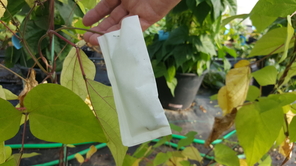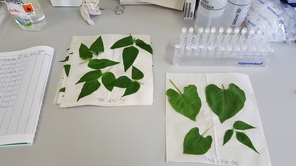Efficient management of resources for smart legumes utilization
Activity Coordinator: Vladimir Meglič Email
The project "Efficient management of resources for smart legumes utilization (SMARTLEG)", submitted by the Grain Legumes Working Group for funding under the Third Call of the ECPGR Activity Grant Scheme, was selected by the Executive Committee and approved in May 2016.
- Activity proposal (342,0 KB)
Approval of the proposal was confirmed in December 2016 after some adjustments requested by the ExCo in the budget and list of partners.
Implementation
February 2023
The SMARTLEG Activity was completed with the publication of the Activity report.
January 2019
Related paper published:
Sinkovič L, Pipan B, Sinkovič E, Meglič V. 2019. Morphological seed characterization of common (Phaseolus vulgaris L.) and runner (Phaseolus coccineus L.) bean germplasm: a Slovenian Gene Bank example. BioMed Research International, vol. 2019, Article ID 6376948, 13 pages, 2019. https://doi.org/10.1155/2019/6376948.
June 2018
The Final Activity report is in preparation.
Summary of results:
In the last decade several thousand accessions were collected in different parts of Europe and are stored in national genebanks; at present the Phaseolus Database as part of the EURISCO Web catalogue contains over 46 000 records. The main objective of SMARTLEG was proper phenotypic and genetic evaluation of European Phaseolus accessions with emphasis on P. coccineus germplasm providing new data to EURISCO and AEGIS. During the project, we provided three different types of datasets including morpho-agronomic traits of plants, morphometric seed characteristics and genetic profiles of P. coccineus accessions from eight Central European geographic origins: Austria, Bosnia and Herzegovina, Italy, Macedonia (FYR), Romania, Serbia, Slovenia and Slovakia. Before sowing, the morphometric characterization of P. coccineus seeds was performed according to adopted Community Plant Variety Office-Technical Protocol and Phaselieu/AIS descriptors observing 14 different seed characteristics. The morphological evaluations were performed upon adjusted descriptors for Phaseolus (ECPGR_PhasChar from Austria) under field conditions in Bosnia and Herzegovina, Macedonia (FYR), Romania, Slovenia and Serbia. A set of 12 already proven and reliably cross-species amplified nSSR markers among P. vulgaris and P. coccineus genomes was applied to evaluate the genetic structure of P. coccineus genotypes. Morpho-agronomical evaluation shows differentiation between P. coccineus accessions even for standard varieties under geographically distinct field conditions. Global principal component analysis extracted four components which cumulatively explain 74.6% of morphometric variability of P. coccineus seeds. Analysis of molecular variability on the basis of allelic patterns reflects 3% of the molecular variability among P. coccineus germplasm from eight different geographic origins, which means that 97% of germplasm is common to all accessions (p>0.01). Regarding the genetic structure of the P. coccineus germplasm from eight geographically distinct collections, three genetic clusters were formatted; the average genetic distance between genotypes in each cluster varies between 0.592 and 0.816. Overall results indicate a common geographic origin of P. coccineus accessions from different collections within Central Europe.
February 2018
The morpho-numerical characterization of P. coccineus seeds was performed according to adopted CPVO-TP and Phaselieu/AIS descriptors observing 14 different seed characteristics. 166 accessions (ACCs) including 17 composite ACCs were obtained from four participating and four self-funded countries. Altogether we assessed 207 ACCs from Austria (16), Bosnia and Herzegovina (18), Italy (7), Macedonia (FYR) (32), Romania (12), Serbia (12), Slovakia (57) and Slovenia (53). Three commercial varieties from different geographic origins of P. coccineus (‘Bonela’ from Austria, ‘Darko’ from Serbia and ‘Emergo’ from Slovenia) were included as standards. Morpho-numeric characterisation covers Seed length (L) [mm], Width in longitudinal cross section (T) [mm], Shape of median-cross section (W) [mm], L/W and W/T ratios, Seed colour, No. of colours, Main colour, Predominant secondary colour, Distribution of secondary colour, Veining, Seed shape, Average 10 seeds weight [g] and Seed colour and coat pattern.
Multiple variable analysis for quantitative measured characteristics regarding to geographic origin of the ACCs is presented in the following figure, depicting Matrix plot for quantitative seed characteristics depending on geographic origin (1-Austria, 2-Bosnia and Herzegovina, 3-Italy, 4-Macedonia, 5-Romania, 6-Serbia, 7-Slovakia, 8-Slovenia).
During the growing season, each partner evaluated morphological characteristics in the field. All selected accessions from different geographic origins (from participating and self-funded partner collections), were evaluated using SSR molecular marker analysis. The molecular marker analysis is being finalized and will be followed by molecular and morphological data management and statistical analysis.
Results of the Activity (final report to be completed by the end of March 2018) are expected to contribute new data to EURISCO and new bean accessions to AEGIS.

October 2017
Further to the meeting held in Ljubljana (April 2017), reference/standard varieties were identified and distributed among partners. Before sowing, morpho-numerical seed characterization was performed according to the Community Plant Variety Office-Technical Protocol (CPVO-TP) and Phaselieu/AIS descriptors for seed morphology. During the growing season, each partner evaluated morphological characteristics in the field.
In addition, the strategy to obtain self-derived progeny from P. coccineus and DNA extraction method suited for genotyping by sequencing, was devised. For that purpose, all 140 accessions were planted in the greenhouse at AIS and self-pollinated by hand.
Since there are no SSRs specifically developed for P. coccineus, a set of 12 already proven and reliable cross-species amplified SSR markers were chosen.
All selected accessions from different geographic origins (from participating and self-funded partner collections), were evaluated using SSR molecular marker analysis to assess genetic background and genetic/molecular diversity.
April 2017
The SMARTLEG project meeting was held 25-26 April 2017 at the Agricultural Insitute of Slovenia (AIS) in Ljubljana. Twenty participants attended the meeting: five project partners, eight observers, six researchers from AIS and a representative from the Ministry for Agriculture, Forestry and Food (see list of participants below).
The coordinator of the SMARTLEG Activity, Vladimir Meglič welcomed the participants and presented the project outline. His presentation was followed by a presentation of the ECPGR Grain Legumes Working Group given by Creola Brezeanu, Chair of the WG. Roberto Papa, coordinator of the ERA-CAPS project Bean_Adapt gave an overview of the project and Barbara Pipan (AIS) presented the Slovene project ‘Utilization of common bean genetic resources for sustainable crop improvement and healthy food'. After the introductory presentations project members and other participants presented the state of the art of Phaseolus collections in their countries.
On the second day the details of the SMARTLEG projects were discussed, i.e. planning of molecular analyses to be conducted at the genetic laboratory of AIS and morphological evaluations in the experimental fields of all project members’ countries. The methodology for morphological evaluations and the reference genotypes were agreed upon.
- Agenda (236,2 KB)
- List of participants (70,1 KB)
- Presentations given at the meeting

